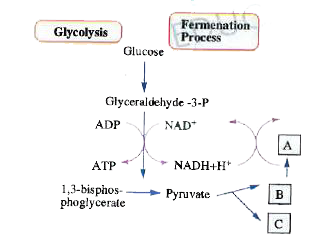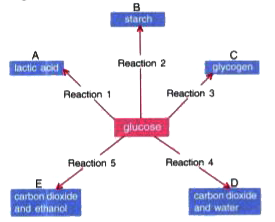Anaerobic respiration in yeast yields
(a) Ethanol and CO2
(b) Lactic acid and O2
(c) CO2 and water
(d) Pyruvic acid and O2
The correct Answer is:A
Step-by-Step Solution:
1. Understanding Anaerobic Respiration: Anaerobic respiration occurs in the absence of oxygen. It is a metabolic process that allows cells to generate energy without using oxygen.
2. Identifying the Organism: In this case, we are focusing on yeast, which is a common organism that undergoes anaerobic respiration.
3. Recognizing the Process: During anaerobic respiration in yeast, glucose is broken down to produce energy. The process involves glycolysis, where glucose is converted into pyruvate.
4. Conversion of Pyruvate: In the absence of oxygen, the pyruvate produced from glycolysis is further converted into acetaldehyde and then into ethanol. This process also releases carbon dioxide (CO2).
5. End Products: The end products of anaerobic respiration in yeast are ethanol (alcohol) and carbon dioxide (CO2).
6. Conclusion: Therefore, the correct answer to the question about what anaerobic respiration in yeast yields is ethanol and carbon dioxide.
Final Answer: Anaerobic respiration in yeast yields ethanol and carbon dioxide.
---
Topper's Solved these Questions
Similar Questions
Knowledge Check
Which of the following options contains the end products formed during anaerobic respiration in yeast?
AH2O,CO2 and energyBH2S,C6H12O6 and energyCCO2,C2H5OH and energyDH2O and CO2During anaerobic respiration, yeast converts glucose into
Aethanol and CO2Blactic acid and CO2Cpyruvic acid and CO2Dethanol and water
Name the following:
Products of anaerobic respiration in yeast.
View SolutionChoose the correct combination of labelling the molecules involved in the pathway of anaerobic respiration in yeast.

View SolutionGiven below are chemical reactions (1 to 5) involving glucose and five other chemical products (A-E).

(a) Write the reaction number of the following:
(i) Anaerobic respiration in plants .........
(ii) End-products in aerobic respiration ...........
(iii) Reaction occurring in liver ............
(iv) Anaerobic respiration in animals ................
(v) Storage in the liver..............
(b) Which reactions (1-5) in the above correspond to the following (write the corresponding number of reaction next to them).
(i) Aerobic respiration
(ii) Change taking place in the liver
(iii) Anerobic respiration in yeast.
(iv) Change taking place in a plant storage organ, e.g., potato.
(v) Anaerobic respiration in animals
View SolutionThe correct sequence of anaerobic reactions in yeast is
View SolutionAnaerobic respiration of yeast produces
View SolutionWhich of the following products are obtained by anaerobic respiration from yeast ?
View Solution
